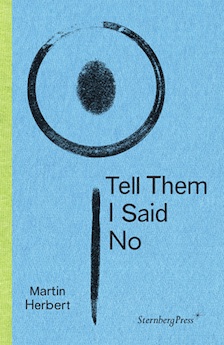By Svetlana Alpers
This is a short, simple, elegantly printed book about ten artists who turned a back on the art world. The title is the words of one of them, Trisha Donnelly, who told her gallery what to say to the writer of the book when he asked for an interview.
It does not seem surprising that an artist might want to retreat to work alone. One has an image of artists past. Cézanne, in Provence for example, stayed put in the land he loved at a distance from his Paris dealer, discouraged visitors, and worked away on his own. Withdrawal seems indeed to be a positive aspect of making art. It is a quality of artistic temperament rather than a comment on the art world. So, how does that play itself out in recent times?
There is only one artist in the book who fits that description. Albert York was a realist painter: a man who was into looking. Leaving his job framing pictures in New York, he settled permanently in East Hampton, Long Island, where he produced, slowly, small paintings that were valued by a coterie including Jackie Kennedy and Lauren Bacall (how did they find him?). He lacked confidence in his work and did not like to talk to people. He did have a wife. The case seems abnormal only by contrast to the outrageous publicity that surrounded the art and artists of his time—Warhol and the rest—whom he did not care for.
Agnes Martin, who was it seems schizophrenic and moved to New Mexico in the face of early success, was more extreme. The rigorously placed lines that mark her mature work are as obsessive as was the choice of the desert solitude where she lived. As with York, there is a temperamental basis for withdrawal, and as with York, it seems to have lodged itself deep in the art making.
Some other artists chosen by Herbert seem to position themselves such that withdrawal itself is the art. D’Arcangelo went so far in self-removal, and it does not seem mistaken to put it this way, as to commit suicide. Lutz Bacher’s refusal to acknowledge her gender and her furtive work—“one big ruin” she said—is made by someone the author describes as a “personality in absentia.” In the case of these two artists, it seems to me it stretches things a bit to speak of their saying no since they recognize nothing outside of themselves to say no to.
Then there are artists who stop making art all together. Their refusal says something about the relationship of art and the artist to the world. Charlotte Posenenske was a conceptual sculptor whose work, akin to factory goods, was collective in its making. But, finally, she despaired of the role of her work in the world, and during the uprisings of 1968, aged thirty-seven, she decided to stop and took a degree in sociology. It has been argued that she did not reject her art work as much as make a decision to carry it on in a new domain. The same might be said of Laurie Parsons. Rather than fashioning elegant structures like Posenenske, she made art of detritus brought into the gallery from the street. Turning back to the people in the street, she stopped making art to work in a psychiatric hospital.
Though all the artists in the book harbor negative feelings about art world institutions—from fear and suspicion to anger—that comes out most clearly in Cady Noland and David Hammons. Noland, herself the daughter of the successful abstract painter Kenneth Noland, seems on the account here to have become consumed by anger to the point where she can no longer make art.
David Hammons, by contrast, is as astonishingly creative as an artist as he is canny as an operator in the world of art. A secretive African-American, he has used the fact that he keeps himself unseen and unheard as a way to fashion a career. He is a marvelously inventive creator who runs things elegantly his own way to his own benefit in terms of money and fame. In his case, the withdrawal is not the work, though it enables it. He uses the stuff of the streets to comment on those forced to live off the streets, even as he uses the stuff of sports, like a basketball hoop, to question those black Americans forced to live off sport, or the stuff of abstract paintings to question the aura they have accrued. Now that I think about it, the wit on view in everything Hammons makes is not a normal characteristic of those who say no. The artists in this book are a rather solemn group.
In sum, the book, or is it the category of artists, turns out to be narrower than I had expected it to be. But it is a book that makes you think anew about art and artists in our time, in fact in any time.
Svetlana Alpers, an artist, critic and renowned art historian, is professor emerita of the history of art at the University of California, Berkeley and a visiting scholar in the Department of Fine Arts at New York University.




